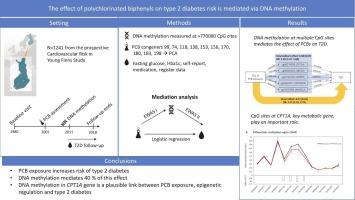多氯联苯对2型糖尿病的影响是通过DNA甲基化介导的
IF 9.7
1区 环境科学与生态学
Q1 ENVIRONMENTAL SCIENCES
引用次数: 0
摘要
多氯联苯(PCBs)已被确定为糖尿病和潜在的表观遗传调节剂。表观遗传变异与2型糖尿病(T2D)的发病机制有关,因此是将多氯联苯暴露与T2D联系起来的潜在机制。本研究通过两项全表观基因组关联研究和中介分析,研究了多氯联苯暴露对T2D风险的影响,以及DNA甲基化(DNAm)在多大程度上介导了这种影响。暴露于多氯联苯,特别是同系物74、99、118、138和183,增加了患T2D的风险(or范围为1.38-1.54)。五个CpG位点被确定为潜在的介质。总之,这些位点的甲基化估计介导了40 %(95 % CI: 20,60 %)的多氯联苯对T2D的影响。最有力的证据是位于CPT1A基因第一个内含子上的cg00574958。这项研究是迄今为止规模最大的评估多氯联苯和T2D之间联系的研究之一,也是第一个调查脱氧核糖核酸介导作用的研究。cg00574958甲基化作为PCB-T2D关系中介的证据支持CPT1A DNA甲基化与一系列代谢表型(包括肥胖、血脂异常和T2D)的广泛复制联系,并表明可能的未来表观遗传干预目标。本文章由计算机程序翻译,如有差异,请以英文原文为准。


The effect of polychlorinated biphenyls on type 2 diabetes risk is mediated via DNA methylation
Polychlorinated biphenyls (PCBs) have been identified as diabetogens and potential epigenetic regulators. Epigenetic variation is implicated in the pathogenesis of type 2 diabetes (T2D) and is therefore a potential mechanism linking PCB exposure and T2D. We here investigate the effect of PCB exposure on T2D risk and the extent to which this is mediated via DNA methylation (DNAm) using two epigenome-wide association studies and mediation analysis.
Exposure to PCBs, especially congeners 74, 99, 118, 138 and 183, increased the risk of T2D (range of ORs 1.38–1.54). Five CpG sites were identified as potential mediators. Together, methylation at these sites was estimated to mediate 40 % (95 % CI: 20, 60 %) of the effect of PCBs on T2D. The strongest evidence was obtained for cg00574958, located in the first intron of the CPT1A gene.
This study is among the largest to date assessing the link between PCBs and T2D, and the first to investigate the mediation by DNAm. The evidence for methylation at cg00574958 as a mediator of the PCB–T2D relationship supports the widely-replicated link of CPT1A DNA methylation to a range of metabolic phenotypes including obesity, dyslipidemia and T2D and indicates a possible future target for epigenetic intervention.
求助全文
通过发布文献求助,成功后即可免费获取论文全文。
去求助
来源期刊

Environment International
环境科学-环境科学
CiteScore
21.90
自引率
3.40%
发文量
734
审稿时长
2.8 months
期刊介绍:
Environmental Health publishes manuscripts focusing on critical aspects of environmental and occupational medicine, including studies in toxicology and epidemiology, to illuminate the human health implications of exposure to environmental hazards. The journal adopts an open-access model and practices open peer review.
It caters to scientists and practitioners across all environmental science domains, directly or indirectly impacting human health and well-being. With a commitment to enhancing the prevention of environmentally-related health risks, Environmental Health serves as a public health journal for the community and scientists engaged in matters of public health significance concerning the environment.
 求助内容:
求助内容: 应助结果提醒方式:
应助结果提醒方式:


